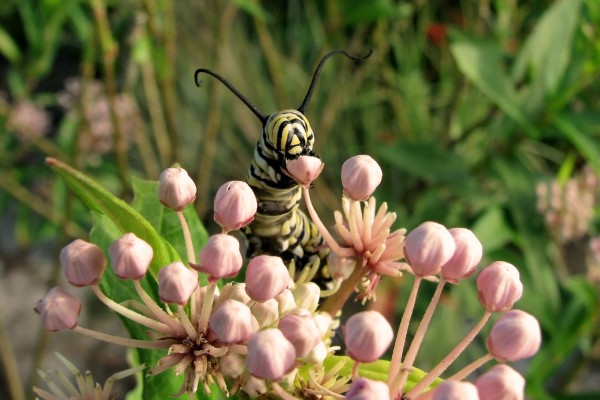and bring home the beauty of real Florida.
Visit FloridaNativeNurseries.org
 Monarch butterfly caterpillar chomps down on native swamp milkweed (Asclepias incarnata).
Monarch butterfly caterpillar chomps down on native swamp milkweed (Asclepias incarnata).The monarch butterfly is one of our most easily recognized butterflies and well known for its long migration across North America. Unfortunately, the loss of natural habitat, in particular native milkweeds, has resulted in dwindling monarch populations vulnerable to other pressures, such as disease and a deadly parasite known as Ophryocystis elktroscirrha (OE), which can be passed from infected butterflies to healthy ones. OE can build up in a population over time.
In Florida, we see migrating monarchs in spring and fall, but also see year-round butterflies who take advantage of our warm climate and the prevalence of non-native tropical milkweed (Asclepias currasivica). This species has showy flowers, is easy to grow and reliably attracts monarchs. While not on the Florida Exotic Pest Plant Council (FLEPPC) list (yet), this plant has spread into natural areas and is often seen on roadsides and in open pastures. It is commonly sold and frequently mistaken as a native species.
Monarchs feed exclusively on milkweed plants (Asclepias species). Butterfly experts such as Dr. Jaret Daniels of the University of Florida believe that the spread of the non-native tropical milkweed may be causing monarch populations to persist longer than they naturally would, making them more vulnerable to OE and thus presenting a risk to other monarch populations. Encouraging monarchs to persist in areas where they would not normally overwinter also subjects them to devastating freezes. Thus, planting the non-native milkweed can have a negative impact on the population of monarch butterflies. By planting native milkweed, particularly the correct native milkweed species for our area, we can help maintain a safe, healthy natural food source that monarchs have relied upon for thousands of years.
Another threat to monarchs is the frequent use of systemic insecticides in the horticultural industry. Milkweed plants purchased from non-native nurseries are much more likely to have been treated with this poison, which persists in the plant tissues, killing caterpillars and causing butterfly eggs not to hatch. Female monarchs feeding on treated milkweed may repeatedly lay eggs with no result.
Florida has more than 20 native species of milkweed, but to date, only three are available in nurseries: butterfly milkweed (Asclepias tuberosa), swamp milkweed (A. incarnata and A. perennis). We hope that future research will lead to increased availability and planting of native milkweed. The Xerces Society is working with other nonprofits and native plant growers to increase the supply of native milkweed available to gardeners and ecological restoration specialists.
Meanwhile, say “no” to tropical milkweed and choose natives to sustain your monarchs for the long haul. Ask for native milkweed at your local retail garden center. Butterfly milkweed (A. tuberosa) is the most available of the native species and is suitable for use in many parts of Florida. However, it grows throughout the United States, so be sure to specify Florida native ecotype. Plants brought in from out of state may not perform to your expectations. If the nursery cannot tell you the origin of the plants (and seed source), ask them to order Florida native ecotype milkweed and if necessary, consider buying elsewhere. Other Florida native milkweeds you may find, particularly at a FANN retail outlet (such as those found on PlantRealFlorida.org), include Swamp milkweed (Asclepias incarnata) and White or Aquatic milkweed (Asclepias perennis).
Native milkweed plants may be hard to find, but it’s worth the effort. Give our monarchs a fighting chance: feed them native milkweed.